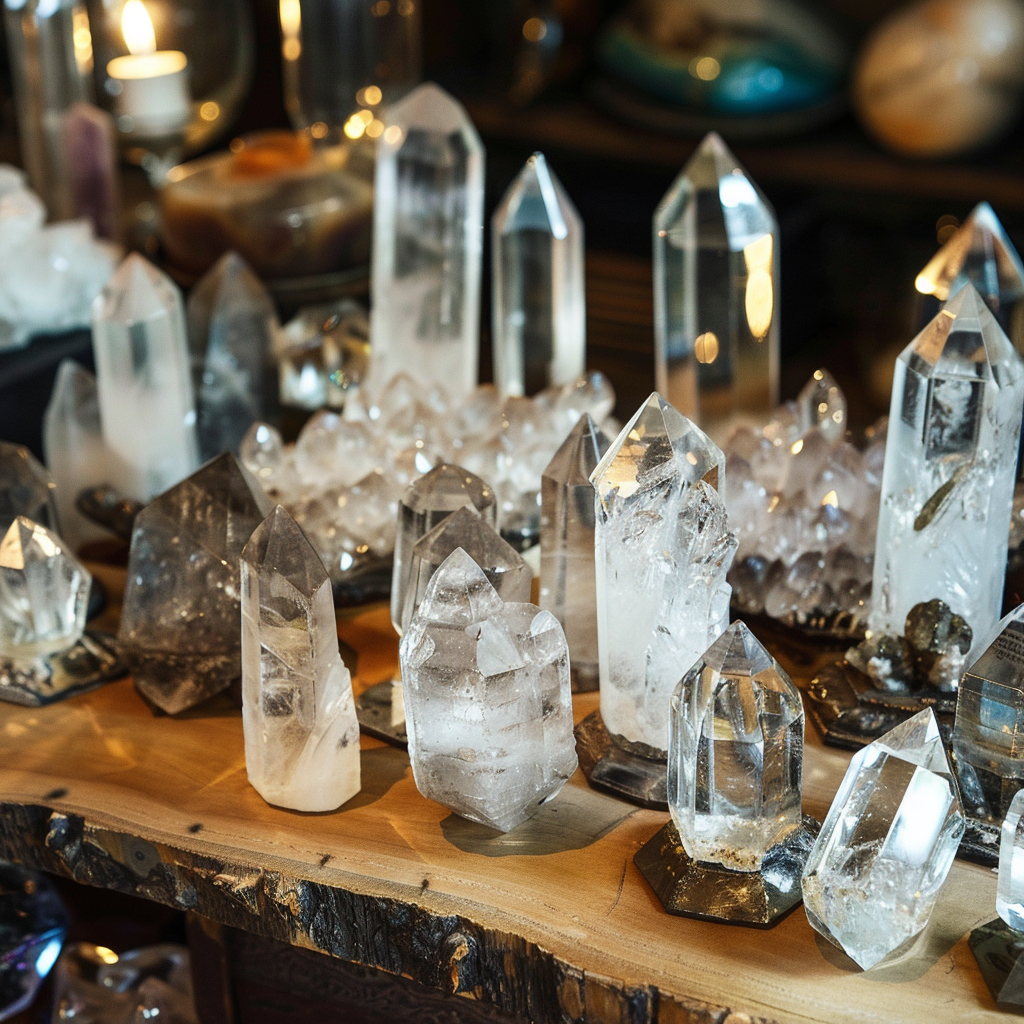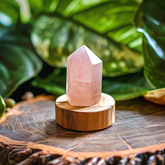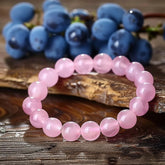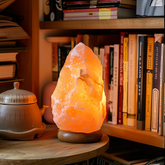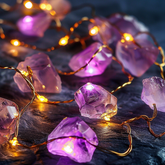Spotting Fake Crystals: A Guide to Authentic Gems
Spotting Fake Crystals: A Guide to Authentic Gems
We've all been drawn in by the beauty of crystals. But with so many fake and synthetic options out there, how do we know we're getting the real thing? Let's start our exploration of crystal authenticity with a story from a gem show.
Imagine a room full of crystals, each one more beautiful than the last. A vendor offered amethysts at prices that seemed too good to be true. Buyers grabbed them, not realizing they were buying imitations. It wasn't until experts checked them out that the truth was revealed - they were just colored glass.
This story shows why it's key to know how to tell real crystals from fakes. Real stones have special traits that set them apart. For example, they feel cold and take time to warm up, unlike fake ones that quickly reach room temperature1. Also, real crystals are usually heavier than fakes of the same size1.
The market is full of synthetic and imitation stones now, so it's vital for buyers to learn about them. Some synthetic stones are made through advanced processes that change their makeup. Others are just glass or plastic made to look like real stones2. This has made it more important than ever to know how to spot real gems.

In this guide, we'll teach you how to confidently shop for crystals. We'll cover the physical traits of real crystals and how to check if they're authentic. This journey is for everyone, whether you're an experienced collector or just starting out. It will deepen your appreciation for the beauty and value of real crystals.
Key Takeaways
- Real crystals often feel cold and warm up slowly compared to fakes
- Authentic gems typically weigh more than imitations of similar size
- Natural crystals usually have imperfections, unlike perfect synthetic ones
- Knowing common pricing helps identify potential fake crystals
- Flame tests can distinguish real crystals from plastic imitations
- Reputable dealers are crucial for ensuring crystal authenticity
Understanding the World of Crystals
Crystals have been fascinating humans for thousands of years. They are thought to vibrate at frequencies that help us find balance3. Each crystal has a unique structure that gives it special benefits3.
Natural vs. Synthetic Crystals
Natural crystals form in the earth over time. Now, lab-grown crystals are becoming more common4. These fake stones are made with the same materials as real crystals, making them hard to tell apart.
The Rise of Fake Crystals in the Market
More people are interested in crystals, which has led to more fake ones being sold3. Some sellers pass off glass gems as real minerals, like 'Cherry Quartz' and 'Blue Obsidian'4. China is a big source of these fake crystals4.
Importance of Authenticity in Crystal Collecting
Real crystals are special because of their unique nature and how they form. Knowing the difference between real and fake is key3. Watch out for prices that seem too good to be true and claims of rarity34. For those looking into crystal energy, knowing the difference between natural and synthetic is crucial.
"In the world of crystals, authenticity is key to unlocking their true potential."
Good sources give clear info on where crystals come from and what they do3. Whether you collect them for looks or healing, making sure they're real deepens your connection to these amazing stones.
Physical Characteristics of Real Crystals
Real crystals have unique features that make them stand out from fake ones. Let's dive into these traits to spot the real deal.
Weight and Density
Crystal density is a key sign of authenticity. Natural crystals are usually heavier than fake ones because they're denser. If a crystal seems too light for its size, it's likely made of glass or plastic5.

Temperature and Heat Conductivity
Heat conductivity is a clue to a crystal's authenticity. Real crystals start cool and warm up slowly when you hold them. This is because they handle heat differently than fake materials. Real crystals have special properties that set them apart from fakes4.
Clarity and Transparency
Crystal clarity can vary. Some are clear, others are not. Real crystals often have inclusions or color changes, which are natural. Fake crystals might look too perfect or have uniform colors without these natural marks45.
| Characteristic | Real Crystal | Fake Crystal |
|---|---|---|
| Weight | Heavier | Lighter |
| Temperature | Cool to touch, warms slowly | Room temperature, warms quickly |
| Clarity | May have inclusions or color zoning | Often too perfect or uniformly colored |
Knowing these physical traits helps us value real crystals more and steer clear of fakes.
Visual Indicators of Authentic Crystals
When we look at crystals, we search for certain signs that show they are real. Natural crystals have unique patterns and color changes that set them apart from fake ones. These features help us spot the real deal.
Real crystals often have uneven patterns and differences in color. If a gemstone looks perfectly even, it's probably not real6. They can also have different colors in different parts, known as color zoning.
Crystals that are truly natural often show special optical effects. These include:
- Asterism (star effect)
- Chatoyancy (cat's eye effect)
- Pleochroism (color change)
- Adularescence (white/blue sheen)
- Aventurescence (shimmer)
- Schiller effect (sparkle)
Be careful of crystals with very bright colors. They're often fake6. Real amethysts, for example, don't stay brightly colored all over6. Citrine, on the other hand, has a distinct lemon-yellow color6.
True crystals have flaws. If a crystal looks too perfect, it might be a fake6. Real clear quartz, for instance, has its own imperfections and doesn't have air bubbles or perfect patterns6.
| Crystal | Authentic Characteristics | Fake Indicators |
|---|---|---|
| Amethyst | Variable color intensity | Consistent bright color |
| Citrine | Lemon-yellow shade | Unnatural orange hue |
| Clear Quartz | Internal imperfections | Perfect clarity, air bubbles |
| Smoky Quartz | Transparent to dark brown/grey | Opaque or unnaturally dark |
Real crystals usually cost more money. Citrine crystals can go from a few dollars to thousands, based on size and quality7. If you find gemstones too cheap, they're likely not real6.
Common Methods to Identify Fake Crystals
Identifying crystals can be tricky, but we have some reliable methods to help. Let's look at three key techniques that can make a big difference in your crystal collection.
The Scratch Test
The scratch test is a simple way to check if a crystal is real. Real crystals are hard on the Mohs hardness scale8. To do this test, scratch the crystal with something hard. If it scratches easily, it might be a fake5.
UV Light Examination
UV light can show secrets in real crystals. Some crystals glow under ultraviolet light. This is great for spotting certain types of quartz and other minerals that glow.

Magnification Inspection
Use a magnifying glass or loupe to get a closer look at your crystals. This lets you see inclusions, internal features, and surface details. Real crystals often have small flaws, veins, or fractures that make them unique5. Fake crystals might look too perfect or have air bubbles, which real stones don't have8.
| Method | What to Look For | Red Flags |
|---|---|---|
| Scratch Test | Resistance to scratching | Easily scratched surface |
| UV Light | Natural fluorescence | No reaction or unnatural glow |
| Magnification | Natural inclusions, fractures | Perfect appearance, air bubbles |
Using these methods together can help us tell real from fake crystals. Remember, real crystals feel cold and have unique patterns with flaws85. Happy crystal hunting!
Fake Crystals: Types and How to Spot Them
In the world of crystal collecting, authenticity is key. We'll explore different types of fake crystals and share tips on how to identify them.
Glass and Plastic Imitations
Glass and plastic imitations are common in the crystal market. These fakes often lack the weight and optical properties of real crystals. A telltale sign is their perfect symmetry and glassy appearance9.
Dyed and Treated Crystals
Dyed crystals are natural stones artificially enhanced to improve their looks. They're easy to spot due to their bright, unnatural colors. Heat-treated amethyst mimicking citrine is widely accepted but not preferred by many crystal enthusiasts10.

Synthetic Crystals vs. Natural Crystals
Synthetic crystals are lab-created stones with the same chemical composition as their natural counterparts. They're often sold as rare crystals at unrealistically low prices. Synthetic quartz, in particular, is produced in a wide range of shapes and colors, primarily in China11.
To avoid purchasing fake or treated gemstones, it's crucial to educate yourself about specific types of crystals before making significant investments. Here's a comparison of energy levels in different crystal types:
| Crystal Type | Energy Comparison to Natural Crystals |
|---|---|
| Heat-treated | 90% |
| Dyed | 30% |
| Synthetic | 20-35% |
| Manufactured (e.g., cubic zirconia, rhinestones) | 0-10% |
Remember, authentic crystals have unique characteristics. They often have imperfections, varying colors, and natural patterns. By understanding these features, you'll be better equipped to spot fakes and build a genuine collection9.
Popular Crystals and Their Fake Counterparts
In the world of crystals, many imitations are found. Fake quartz, imitation amethyst, and synthetic sapphire are flooding the market. This trend affects both scientific rockhounds and spiritual crystal enthusiasts11.
Let's look at some popular crystals and their fake versions:
- Citrine: Most stones sold as citrine are actually heat-treated amethyst or smoky quartz. Real citrine is rare and expensive12.
- Turquoise: Less than 5% of mined turquoise is good enough for jewelry. Fake versions are common. Magnesite and howlite are often dyed blue to look like turquoise1211.
- Moldavite: Because of high demand, many fake versions exist. Genuine moldavite is a natural glass found only in the Czech Republic12.
- Onyx: Black onyx is often dyed grey chalcedony. Natural onyx comes in many colors and patterns12.

Be careful with "enhanced" crystals too. Aqua aura quartz, for example, is made by coating quartz with metal oxides11. Most Arkansas smoky quartz has been made artificially11.
Online marketplaces have made it easier for sellers to sell lab-grown or plastic imitations. Synthetic quartz from China is very common11. Always do your research and buy from trusted sources to avoid fake products1211.
Purchasing Authentic Crystals: Tips and Tricks
Buying real crystals needs knowledge and care. Here are key tips to make sure you get the genuine article from trusted sellers.
Reputable Dealers and Sources
It's important to buy from reliable sources. Choose dealers with good reviews and lots of experience13. They should offer detailed info on each crystal's properties and uses13.
Be cautious of sellers who use high-pressure sales or offer prices that seem too low. A wide range of crystals and detailed shop displays often mean quality products13.
Questions to Ask Before Buying
Always ask questions before you buy. Ask about the crystal's origin and any treatments it had. For expensive stones, ask for certification to prove it's real.
- Where was the crystal sourced?
- Has it undergone any treatments or enhancements?
- Can you provide certification for this stone?
Asking about the crystal's source ensures it's of high quality and mined ethically13. Talking clearly with sellers helps you avoid fake crystals and make smart choices.
Understanding Pricing and Value
Prices for gemstones vary a lot due to rarity, quality, and size. Watch out for deals that seem too cheap, as they usually are. Look at prices from different sellers to understand what's normal for certain crystals.
| Crystal Type | Price Range (USD) | Factors Affecting Price |
|---|---|---|
| Quartz | $5 - $50 | Size, clarity, formation |
| Amethyst | $20 - $200+ | Color intensity, size, origin |
| Citrine | $10 - $100 | Natural vs. heat-treated, size |
Some stones, like agates and amethysts, may look vibrant but could be enhanced artificially, lowering their value14. Learn about crystals to make wise buys.
By following these tips and staying informed, you'll be ready to gather a collection of real, quality crystals for your spiritual or decorative needs.
Tools and Resources for Crystal Authentication
Crystal lovers and collectors can use many gemological tools and crystal testing kits. These tools help identify minerals. With more people wanting crystals, knowing if a crystal is real is very important15.
A gemological loupe is a small magnifying glass for looking closely at crystals. UV lights show if minerals glow under certain light. Refractometers check how light bends through crystals to help identify them.
Books with pictures of crystals are key for comparing and finding real ones. They give info on crystal features to help spot fakes15. Online databases have lots of info on crystals and how to tell them apart.
Advanced methods like Raman spectroscopy can tell real gemstones from fake ones. This is especially useful for stones often copied, like diamonds and rubies16.
| Tool | Function | Effectiveness |
|---|---|---|
| Gemological Loupe | Magnification | High for surface examination |
| UV Light | Fluorescence testing | Moderate for certain minerals |
| Refractometer | Measures refractive indices | High for specific identification |
| Raman Spectroscopy | Chemical composition analysis | Very high for authenticity verification |
For real crystals, it's key to check out sellers and watch for warning signs. Low prices, perfect shapes, and too bright colors often mean it's a fake1517. Using these tools and resources helps collectors make smart choices and gather real crystals.
Conclusion
In our journey through crystal authentication and gemstone education, we've explored the complex world of authentic crystals. We found that beliefs greatly influence how people feel about crystals. A study showed that 74 out of 80 people felt something during crystal meditation, whether they had real or fake quartz18.
The crystal market faces big challenges with authenticity. Some sellers offer fake or treated crystals for more money. They use coloring, heat, and wrong labels19. This makes it tough for buyers to know what they're getting.
To protect yourself, learn about crystal properties and common fakes. Use the tools and methods we've shared for checking crystals. Remember, even experts can be tricked sometimes. Stay curious, keep learning, and trust your gut when buying crystals.
FAQ
What are some common types of fake crystals?
Fake crystals include glass or plastic copies, crystals dyed or treated, and synthetic ones meant to look like real gemstones.
How can I identify real crystals from fakes by their physical properties?
Real crystals are denser and heavier than fake ones. They also feel colder and warm up quickly. You can spot them by looking for inclusions and color changes under a magnifying glass.
What are some visual indicators of authentic crystals?
True crystals show natural color changes, special light effects, and unique patterns. Fakes usually don't have these natural features.
How can I test for fake crystals using common methods?
You can use the scratch test, UV light, and a magnifying glass to check for real crystals. Mixing these tests helps tell real from fake.
What are some popular crystals that are frequently imitated?
Many crystals are copied, like synthetic quartz pretending to be citrine or amethyst. Glass or plastic can mimic turquoise, and cubic zirconia is often sold as diamonds. Jade, opal, ruby, and sapphire are also commonly faked.
What should I look for when purchasing crystals to ensure authenticity?
Buy from trusted sellers and ask about the crystal's origin and any treatments. Check for certifications on expensive stones. Be wary of very low prices, as they might mean the crystal is fake.
What tools and resources can help with crystal authentication?
Tools like gemological loupes and UV lights are helpful. So are refractometers, crystal guides, and online resources. Gemological databases can also provide important information for identifying real crystals.
Source Links
- How to Tell If a Crystal Is Real: 10 Signs + Common Fakes
- Fake Crystals and How to Identify Them
- Beginner's Guide to Buying Crystals | Find the Perfect Crystal & Avoid Fakes
- Real Vs Fake Crystals: How to Tell If A Crystal Is Real
- How to Tell if a Crystal Is Real | 9 Best Ways & Common Fakes
- Real Vs Fake Crystals: How To Tell If A Crystal Is Real
- Real Vs. Fake Citrine: How to Spot the Difference
- How To Tell If A Crystal Is Real | Conscious Items
- How To Tell If A Crystal Is Real | Healing Crystal Shop Online
- Tucson Gem Show Tips & Spotting Crystal Fakes
- Your 'healing' crystals might not even be crystals
- Commonly Faked or Man-Made Crystals
- Navigating A Crystal Shop: A Beginner's Guide to Buying Crystals
- How to Shop Smart and Avoid FAKE Crystals | Genuine Healing Crystals and Stones
- How To Tell If A Crystal Is Real? 15 Easy Tips + Tests To Try
- Gemstone Analysis and Authentication | Ocean Optics
- How To Tell If A Crystal Is Real?
- Healing Crystals: Is It A Hoax Or Does It Really Work?
- FAKE CRYSTALS-


